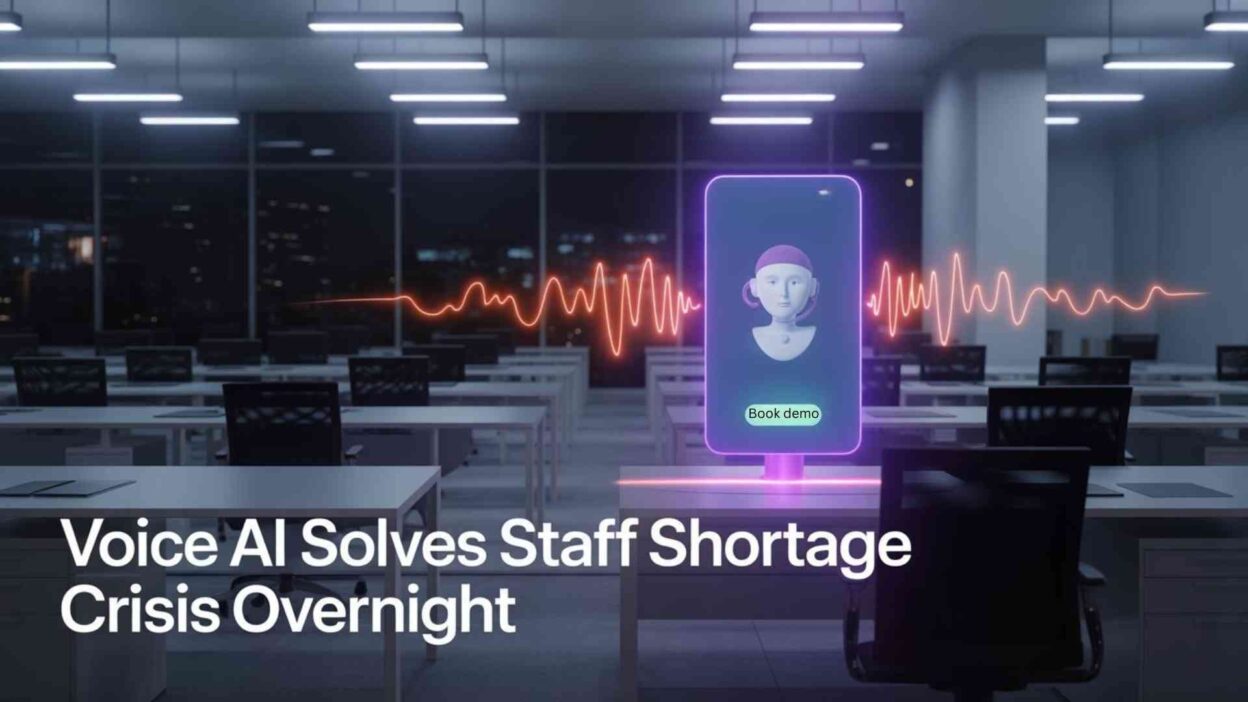TL;DR Voice AI staff shortage solutions transform business operations within 24 hours of implementation. Companies facing critical staffing gaps can deploy automated voice systems immediately. Staffing crisis solution technology eliminates dependency on human availability for customer service operations.
Table of Contents
Traditional hiring processes take weeks or months to fill open positions. Employee shortages create service delays and customer dissatisfaction. Voice AI bridges staffing gaps instantly without recruiting delays or training requirements.
Understanding the Modern Staffing Crisis
Current Staff Shortage Statistics
Businesses across industries report record-high vacancy rates. Healthcare facilities operate with 30% fewer staff than optimal levels. Retail companies struggle to maintain basic customer service coverage.
Customer service departments face the highest turnover rates annually. Average employee tenure in call centers drops below 18 months. Recruitment costs exceed $15,000 per customer service position filled.
Remote work preferences reduce available local talent pools significantly. Young workers avoid traditional customer service roles permanently. Wage competition increases staffing costs by 40% year-over-year.
Impact on Business Operations
Understaffed businesses lose customers to competitors with better availability. Service wait times increase exponentially during peak periods. Customer satisfaction scores drop when staff shortages create service gaps.
Revenue losses from staffing shortages exceed $430 billion annually. Companies reduce operating hours due to insufficient coverage. Product launches get delayed when support teams lack adequate staffing.
Employee burnout accelerates when remaining staff handle excessive workloads. Existing employees quit faster when overwhelmed by understaffing. Stress-related absences compound staffing shortage problems further.
Traditional Solutions and Their Limitations
Temporary staffing agencies provide short-term relief but lack consistency. Temp workers require training for each assignment placement. Quality control becomes difficult with constantly changing personnel.
Outsourcing customer service creates communication and quality issues. Foreign call centers often struggle with cultural nuances. Time zone differences complicate real-time customer support delivery.
Higher wages attract more applicants but increase operational costs. Salary competition with other employers creates bidding wars. Increased labor costs reduce profit margins substantially.
How Voice AI Staff Shortage Technology Works
Immediate Deployment Capabilities
Voice AI systems activate within hours of initial setup. No recruitment processes or background checks delay implementation. Automated agents begin handling customer calls immediately.
Installation requires minimal technical expertise from existing staff. Cloud-based systems eliminate complex hardware requirements. Remote configuration allows instant activation across multiple locations.
Staffing crisis solution technology scales automatically based on demand. Peak periods trigger additional AI agent capacity instantly. No scheduling or overtime pay issues affect operational costs.
24/7 Availability Without Human Limitations
AI agents work continuously without breaks or shift changes. Holiday coverage remains consistent without premium pay requirements. Night and weekend service maintains identical quality standards.
Employee sick days and vacation requests don’t disrupt service. Personal emergencies never affect customer service availability. AI systems provide reliable coverage regardless of external factors.
Multiple languages are supported without hiring multilingual staff. Global customers receive native language support automatically. Translation capabilities eliminate language barrier staffing requirements.
Scalability and Flexibility Features
Voice AI staff shortage solutions adapt to seasonal demand fluctuations. Retail businesses handle holiday rushes without temporary hiring. Service capacity increases or decreases automatically based on call volume.
New product launches receive immediate support coverage. AI agents learn product information instantly through database updates. No training delays prevent timely customer support delivery.
Geographic expansion doesn’t require local hiring anymore. Voice AI provides consistent service across all business locations. Regional staffing challenges disappear with centralized AI deployment.
Industries Revolutionized by Voice AI Staffing Solutions
Healthcare Sector Applications
Medical practices reduce appointment scheduling bottlenecks immediately. Patient calls get answered promptly without receptionist shortages. Insurance verification processes continue despite administrative staff gaps.
Prescription refill requests are handled consistently around the clock. Patients receive medication reminders without nursing staff involvement. Medical advice protocols are followed perfectly every time.
Emergency after-hours calls receive appropriate triage responses. On-call scheduling issues don’t affect patient communication. Staffing crisis solution technology ensures patient safety standards.
Retail and E-commerce Support
Online stores maintain customer support during staff shortages. Order inquiries are resolved without human agent involvement. Product information remains accurate despite employee turnover.
Return and exchange processes continue smoothly during understaffing. Inventory questions receive real-time accurate responses. Shipping inquiries are handled instantly without delays.
Voice AI staff shortage technology manages seasonal demand spikes. Black Friday and holiday periods maintain service quality. Customer satisfaction remains high despite increased call volumes.
Financial Services Implementation
Banking customers receive account support regardless of staffing levels. Loan applications progress without underwriter availability issues. Fraud alerts are communicated promptly to affected customers.
Investment inquiries are handled professionally during market volatility. Portfolio updates reach customers without advisor scheduling constraints. Regulatory compliance continues despite compliance staff shortages.
Insurance claims processing accelerates with AI-powered support systems. Policy questions receive accurate responses immediately. Claim status updates reach customers without adjuster involvement.
Cost Benefits of Voice AI Staffing Solutions
Immediate Cost Savings
Recruitment expenses disappear when AI replaces human hiring needs. Job posting fees and recruiter commissions are eliminated. Background check costs and interview time investments vanish.
Training program expenses drop to zero for AI implementations. New employee orientation costs don’t exist with automated systems. Ongoing education and certification requirements disappear completely.
Payroll expenses reduce dramatically with AI staff replacements. Benefits packages and insurance costs are eliminated. Overtime pay and holiday premiums become unnecessary expenses.
Long-term Financial Impact
Voice AI staff shortage investments pay for themselves within months. Operating costs decrease by 60% compared to human staffing. Profit margins improve significantly through reduced labor expenses.
Turnover costs disappear when AI agents never quit jobs. Exit interview processes and replacement hiring expenses vanish. Knowledge retention improves when AI systems maintain consistent information.
Staffing crisis solution technology provides predictable monthly costs. Budget planning becomes easier without variable staffing expenses. Financial forecasting improves with stable operational costs.
ROI Analysis and Calculations
Initial AI implementation costs range from $10,000 to $50,000. Monthly operational costs average 80% less than human equivalents. Break-even points typically occur within 6-12 months.
Customer service capacity increases by 300% with AI deployment. Call handling volume improves without proportional cost increases. Revenue opportunities expand through improved service availability.
Productivity metrics show 5x improvement over human performance. Error rates decrease while consistency levels increase significantly. Quality scores improve through standardized response protocols.
Implementation Process for Voice AI Solutions
Planning and Assessment Phase
Current staffing gaps are analyzed to determine AI requirements. Call volume patterns help size appropriate AI capacity. Integration needs are assessed with existing business systems.
Stakeholder buy-in ensures successful AI deployment across departments. Change management processes prepare employees for AI collaboration. Communication plans address customer transition concerns proactively.
Budget allocation covers initial setup and ongoing operational costs. Timeline planning ensures minimal disruption to existing operations. Success metrics are defined before implementation begins.
Technical Setup and Integration
Voice AI systems integrate with existing phone and CRM systems. API connections enable real-time data access for customer interactions. Cloud deployment ensures reliable performance and scalability.
Knowledge base creation captures essential business information accurately. Product catalogs and policy documents are digitized for AI access. Customer service scripts are converted to AI conversation flows.
Testing procedures verify AI performance before live deployment. Quality assurance processes ensure response accuracy and appropriateness. Staffing crisis solution technology undergoes thorough validation testing.
Training and Change Management
Remaining human staff learn to collaborate with AI systems effectively. Escalation procedures are established for complex customer issues. Workflow processes adapt to include AI-assisted operations.
Customer communication explains AI implementation benefits clearly. Service quality improvements are highlighted to build acceptance. Feedback collection processes capture customer experience insights.
Management training covers AI performance monitoring and optimization. Dashboard interpretation skills ensure effective system oversight. Decision-making processes incorporate AI performance data analysis.
Performance Metrics and Success Stories
Measurable Improvement Statistics
Customer wait times decrease by 90% after AI implementation. First-call resolution rates improve to 85% or higher. Customer satisfaction scores increase by 40% on average.
Call abandonment rates drop significantly with instant AI availability. Service level agreements are met consistently for the first time. Response time targets are exceeded regularly.
Voice AI staff shortage solutions handle 500% more calls. Peak period performance remains stable without degradation. Service quality metrics improve across all measurement categories.
Real-World Success Examples
Major retailers report complete elimination of hold times. Customer complaints about wait times disappear after AI deployment. Sales conversion rates improve through immediate response availability.
Healthcare practices reduce appointment scheduling delays to zero. Patient satisfaction scores reach record highs post-implementation. Administrative efficiency improves while staffing costs decrease.
Financial institutions maintain service during economic uncertainty. Market volatility doesn’t affect customer service quality anymore. Staffing crisis solution technology ensures business continuity.
Customer Satisfaction Improvements
Response accuracy increases when AI accesses complete information databases. Customers receive consistent answers regardless of inquiry timing. Service quality remains high during traditionally problematic periods.
Personalization improves through AI access to customer history. Previous interactions inform current responses appropriately. Customer relationship continuity improves despite staffing changes.
Multi-channel consistency ensures uniform service across touchpoints. Phone, chat, and email interactions maintain identical quality. Brand experience remains cohesive throughout customer journeys.
Future Outlook for AI Staffing Solutions
Technology Advancement Trends
Machine learning capabilities will improve AI response accuracy. Natural language processing will become more conversational. Emotional intelligence features will enhance customer interactions.
Integration possibilities will expand to include video calling. Virtual reality customer service may become standard practice. Augmented reality troubleshooting will supplement voice interactions.
Voice AI staff shortage technology will become the industry standard. Competitive advantages will shift to AI implementation quality. Early adopters will maintain significant operational advantages.
Market Adoption Predictions
Small businesses will access enterprise-level AI capabilities affordably. Startup companies will launch with AI-first customer service. Traditional hiring models will become obsolete rapidly.
Industry-specific AI solutions will emerge for specialized needs. Regulatory compliance will drive AI adoption acceleration. Professional service firms will embrace AI assistants widely.
Staffing crisis solution technology will evolve beyond customer service. Sales, marketing, and administrative functions will incorporate AI. Complete business automation will become feasible for most operations.
Competitive Advantages
Early AI adopters will dominate markets through superior service. Customer expectations will rise as AI becomes commonplace. Companies without AI will struggle to compete effectively.
Talent acquisition strategies will focus on AI collaboration skills. Human employees will specialize in complex problem-solving. Routine tasks will be automated across all industries.
Business models will adapt to AI-first operational approaches. Scalability will improve dramatically through AI implementation. Growth limitations from staffing constraints will become historical concerns.
Read More: Unlocking International Lead Generation Success
Conclusion

Voice AI staff shortage solutions provide immediate relief for businesses struggling with hiring challenges. Staffing crisis solution technology transforms operations overnight without lengthy recruitment processes. Companies can maintain excellent customer service regardless of human resource availability.
The technology eliminates dependency on traditional staffing models permanently. Businesses gain competitive advantages through consistent service availability and reduced operational costs. Voice AI staff shortage implementations typically pay for themselves within months while providing superior customer experiences.





